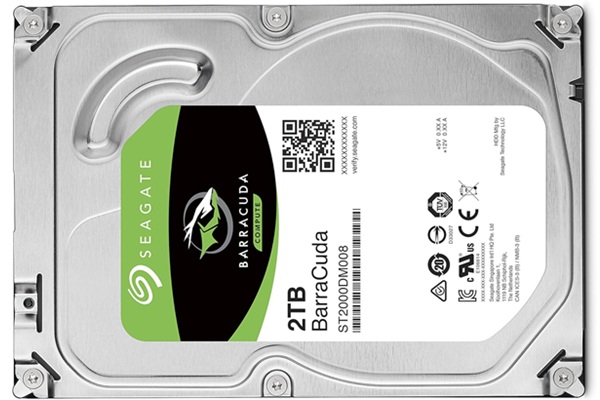
|
|
How Hard Drives and SSD's Compare
Spinners vs SATA vs NVMe (Gen3, 4 & 5)
There are two main families of storage you’ll see in PCs today: traditional spinning hard drives (HDDs) and solid-state drives (SSDs). SSDs split into SATA SSDs (which use the older SATA interface) and NVMe SSDs (which use PCI Express lanes for much faster speeds).
SATA spinning drives (HDD) vs SATA SSD
 Seagate HDD Product Photo
Seagate HDD Product PhotoSATA HDD (spinning drive): These drives store data on
spinning platters and read/write with a mechanical head. They are great for having a lot
of cheap storage (large backups, media libraries, game libraries) but are slow compared
with SSDs. Typical real-world sequential speeds for modern 3.5" 7200 RPM drives are
often in the 80–200 MB/s range (mechanical limits and platter density
matter a lot).
 Samsung SATA SSD Product Photo
Samsung SATA SSD Product PhotoSATA SSD: These are solid-state (no moving parts) but use
the SATA interface. SATA III is commonly called “6 Gb/s” (gigabits per second) on paper,
which translates to a theoretical top in the hundreds of MB/s in real transfers. In
practice SATA SSDs top out far below the speeds of NVMe SSDs because the SATA controller
and protocol were designed for HDDs.
Use for bulk storage where cost per TB matters. These are great for NAS drives and security camera systems.
When to pick SATA SSD:
Use for older systems or laptops without NVMe support; big speed jump over HDD for OS/apps.
NVMe SSDs (PCIe-based) — Gen3, Gen4, Gen5
 SK Hynix Gen 4 NVME Product Photo
SK Hynix Gen 4 NVME Product PhotoNVMe SSDs talk directly to the CPU over the PCI Express (PCIe) lanes. That means much higher bandwidth and lower latency. Each PCIe generation roughly doubles raw transfer rate per lane.
Raw signaling: 8.0 GT/s per lane → about ~985 MB/s per
lane (after encoding). A common NVMe M.2 drive uses x4 lanes, so Gen3 x4 yields
roughly ~3.9 GB/s peak link bandwidth in ideal conditions.
Raw: 16 GT/s per lane → roughly ~1.97 GB/s per lane. A
Gen4 x4 NVMe drive can hit ~7.8 GB/s link bandwidth (theoretical).
Raw: 32 GT/s per lane → roughly ~3.94 GB/s per lane. A
Gen5 x4 NVMe drive can approach ~15.7 GB/s of link bandwidth in ideal cases.
Gen5 drives are newer and mostly seen in high-end or data center gear as of
recent years.
Real drives never hit theoretical maxima because of controller limits, NAND type, thermal throttling, and OS/queue limits. Still, NVMe Gen4 and Gen5 SSDs deliver much higher sequential speeds and far better IOPS (small random reads/writes) than SATA drives.
PCIe lanes and practical meaning
Every M.2 NVMe SSD usually uses x4 PCIe lanes (that’s how most consumer
sticks are wired). The slot on your motherboard may be wired
as x4, x2, or share lanes with other devices (like SATA ports or GPUs). GPUs commonly
use x16 slots. More lanes = more potential bandwidth.
- x1, x4, x8, x16: these numbers are how many PCIe lanes a device uses. An NVMe x4 is the common consumer standard.
- Sharing lanes: on many motherboards some M.2 slots disable SATA ports or steal CPU lanes when populated — check your board manual.
For everyday users, the practical takeaway: a Gen3 x4 NVMe is already a big step up over SATA SSDs for boot times and app loads. Gen4 and Gen5 drive options are useful for very large file transfers, pro workloads, or future-proof builds.
Extra facts that matter
- Latency: SSDs have much lower access latency than HDDs. That’s why apps and the OS feel snappier on SSDs.
- IOPS: For many small reads/writes (like loading many files or running databases), NVMe SSDs with high IOPS beat SATA drives drastically.
- Endurance & NAND: SSDs use NAND flash (QLC/TLC/MLC/SLC types). Higher-density NAND gives more capacity for less cost but often lower endurance.
- Thermals: High-speed NVMe drives can heat up and throttle; heat spreaders or motherboard heatsinks help sustained speeds.
- Form factors: NVMe commonly uses M.2; enterprise NVMe also uses U.2 and EDSFF form factors for servers.
When building or upgrading, balance capacity, speed, endurance, and cost. A common modern combo is an NVMe boot drive (OS/apps) + HDD for mass storage.
Which should you pick?
- Price-conscious bulk storage: HDD (spinning drive).
- Old laptop or simple upgrade: SATA SSD — much faster than HDD and cheap.
- Gaming, content creation, fast everyday use: NVMe Gen3 x4 or Gen4 x4 (if your motherboard/CPU supports it).
- Pro workstations, servers, heavy editing or large datasets: Gen4 or Gen5 NVMe — if your platform supports and you need huge sequential speeds.
Summary:
SATA HDDs are cheap for mass storage. SATA SSDs are an easy speed upgrade. NVMe SSDs (over PCIe lanes) deliver far higher bandwidth and lower latency — Gen4 and Gen5 double lane speeds compared with previous generations. Match the drive to your budget and workload.
Related Articles
This is a complete list of harddrive related articles on this website.
#0092 [EDUCATION]
How Hard Drives and SSDs Compare
#0075 [BUYERS
GUIDE] What Do WD Hard Drive Colors Mean?
#0056 [EDUCATION]
Understanding Bad Sectors on a Hard Drive
#0041 [EDUCATION]
Spinning Rust (Hard-Drives) vs SSD
#0005 [INFO] Data
Transfer Services - Let's move your stuff!
#0004 [INFO] Data
Recovery Services for failing spinning drives

